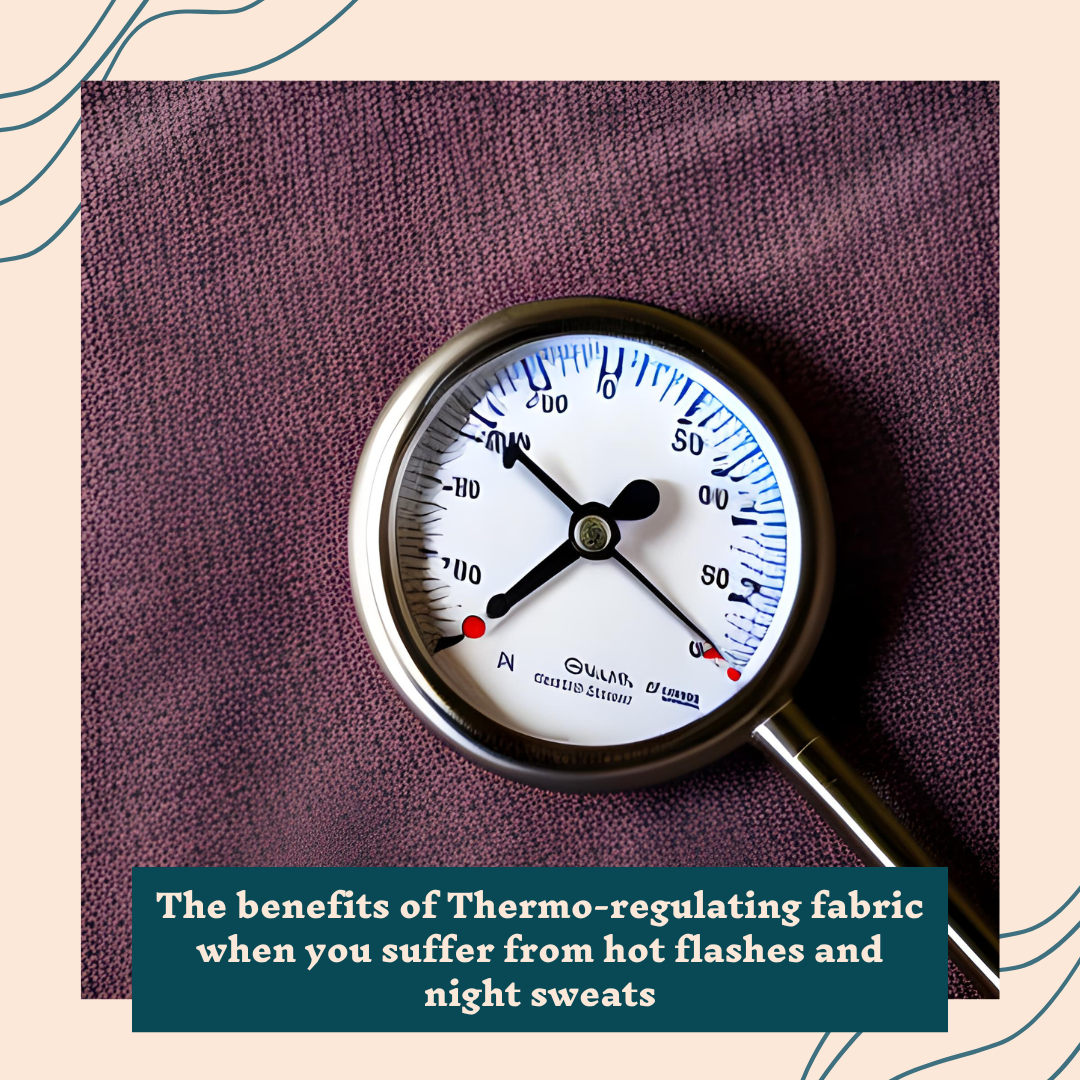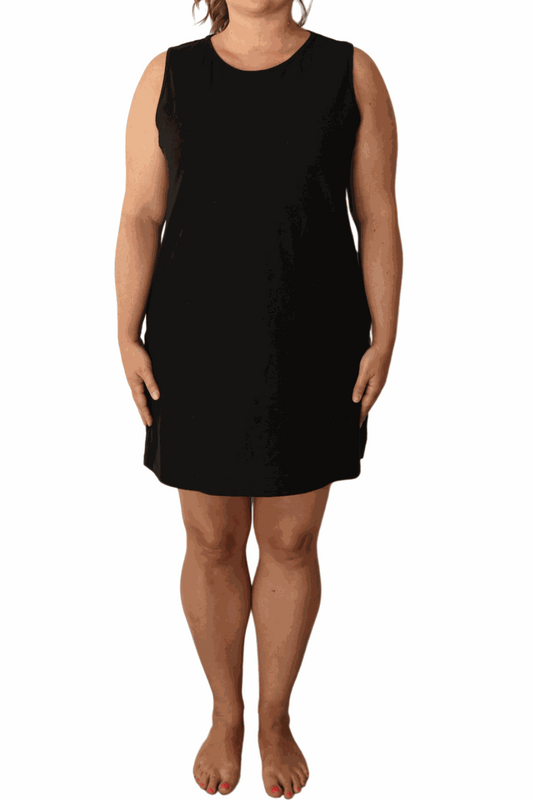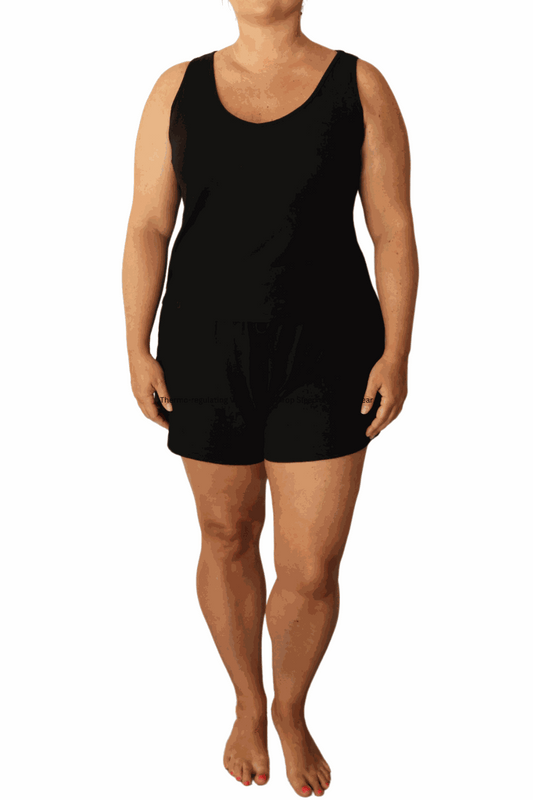
Thermoregulating Fabric: A Cool Solution for Hot Flashes and Night Sweats
Share
(This post was updated on November 15 2023)
I used to suffer from horrible, awful, terrible night sweats - the chronic kind. Every single night without fail I would wake up bursting into flames (or so it felt), so that I’d toss the covers off to find cool relief. A few minutes later, just as I was drifting back to sleep, I’d wake up again, shivering, cold and damp and have to grab my covers to get warm again. The cycle would repeat itself all night, seemingly non-stop. I’d get up in the morning exhausted, drained, clammy, and barely able to get through the day. This cycle went on for over a year, approaching two years, before I finally did something about it.
Sometimes I’d stare at the ceiling at night, wide awake, flipping my covers on and off endlessly, thinking that there had to be sleepwear fabric out there that could absorb heat and sweat and essentially flatten the night sweats curve so I could sleep through the episodes uninterrupted.
Thermo-regulating Fabric and Its Benefits
I come from the green building world. In the area of natural building materials, there are thermo-regulating materials, which act as room “comfort modulators,” absorbing humidity and heat (within a range) in an interior space in order to keep it at a comfortable temperature. Common materials for this purpose are clay, lime, bamboo, wood and hemp. Their natural properties are such that they absorb humidity and heat as rooms heat up past a certain temperature and release them when they drop below certain levels. These materials work passively, no fancy mechanical equipment necessary. They are quiet, low maintenance and zero cost once installed.
I knew that there were fabrics that could do the same thing for humans: absorb the heat and sweat given off due to our internal and unpredictable furnace. They could draw the heat and sweat away from us to the outside and then release it back to us as our body cooled down again. These are known as thermo-regulating fabrics.
Some natural fibres have unique inherent structures that actively respond to the moisture and heat to which they’re exposed. Most of them (but not all) last a long time and clothing and sleepwear made from them can become your "desert island" pieces, allowing you to feel comfortable even when you're having a hot flash or night sweat.
In this article we’ll go over why night sweats are so debilitating, how thermo-regulating fabric works, what effect it can have on your sleep and how to select the right sleepwear to help you sleep better.
The Agony of Chronic Night Sweats
If you suffer from night sweats you know firsthand that they lead to sleep deprivation. The direct reason for the sleep deprivation has to do with the inability to get enough of the three different stages of sleep: light, REM and deep sleep. While you might get enough light sleep, your chances of getting sufficient REM (rapid eye movement – the dreaming stage) and deep sleep are slim if night sweats are occurring several times per night. Not getting enough of these two stages each night will lead to sleep deprivation. The effects of sleep deprivation can be noticed in little as 4 days of poor sleep.
Sleep deprivation in both the short and long term can have serious health consequences. In the short term there are physical and mental health effects. Your body craves carbs, especially sugar, while you won’t have enough energy to exercise, both of which can lead to weight gain. In addition, the lack of sleep leaves you impatient and can lead to poor judgement. Finally, you may begin to withdraw from all but essential tasks at work, home or extra-curricular activities.
The long-term consequences of sleep deprivation are increased physical health risks such as high blood pressure, heart disease, weight gain, depression and mental clarity.
So, getting your sleep back when you suffer from night sweats is essential to your short and long-term well-being.
Why Finding the Right Thermo-regulating Sleepwear Is Essential for a Good Night's Sleep
There are many solutions available to help manage night sweats, but these solutions will vary depending on the cause. If you’re in a stage of menopause, such as perimenopause or post-menopause, night sweats are a common symptom of your shifting hormones. Surprisingly for many, perimenopause symptoms can start 8-10 years before you reach your one day of menopause. If your night sweats keep you up at night (as mine did), you may want to discuss options with your doctor or health care practitioner. While hormone replacement therapy (HRT) is a common and effective solution, there are many women who need additional help to calm the night sweats, or who, for many reasons, don’t use it.
There are also natural alternatives to also help you reduce the effect of your menopausal night sweats.
For non-menopause related night sweats, the solutions might not be as plentiful, so getting the right bedding and sleepwear becomes that much more important to getting a good night’s sleep.
The right sleepwear can help you sleep more comfortably with night sweats and wake up refreshed in the morning – instead of exhausted and drained. Essential to the right type of fabric is its ability to manage the heat and sweat you generate. This action is accomplished by thermo-regulating fabric.
What Is Thermo-regulating Fabric?
Thermo-regulating materials in general are materials that moderate the local environment so it stays within a constant temperature and humidity range. In the case of thermo-regulating fabrics, they can absorb and release heat and sweat produced by your body, drawing it away from you, then releasing back to you as you cool down. A small amount of heat is stored within the fabric itself while sweat is pulled through the fabric to the outside where it can evaporate or be absorbed by the next layer of fabric. The heat stored in the fabric is released back to you as your body temperature drops. This action helps prevent that chilled feeling you get after a night sweat, and it means you wake up less often to adjust your covers.
How Thermo-regulating Fabric Works: Adapting to Body Temperature Fluctuations
Natural fabrics are unique in that unlike synthetic fabrics, it is their inherent, or natural, physical structure that determines the thermo-regulating properties.
Night sweats differ from being either constantly hot or cold. In either of these instances, you can adjust your bedding and sleepwear to suit that constant condition and once you’ve got it right, you can (hopefully) sleep uninterrupted and wake up restored and ready to start your day.
Night sweats are due to a constantly fluctuating internal mechanism that’s telling your body it’s time to cool off. Once your body has done its “cooling off”, flushing out all that heat, your temperature plummets below your normal basal temperature. So, not only do you feel chilled from the damp sleepwear, you are also actually chilled due to a dropping body temperature. Thermo-regulating fabric works to absorb and release heat as you need it, thereby keeping you comfortable all night long, allowing you to sleep better and less interrupted. It will flatten the peaks and valleys of your night sweats.
Choosing sleepwear: how to know if the sleepwear is thermo-regulating?
There isn’t a ton of choice around thermo-regulating fabric. It’s still not a well-known field, and yet, it’s an important one. In the menopause category alone, as many as 75% of all women will experience night sweats and/or hot flashes. While they won’t last long for many, they can last for years, if not be permanent for many.
In the case of synthetic thermo-regulating fabric, you will find that most companies will specifically mention this feature on their hangtags.
In the case of natural fabric, it’s very possible that that property will go unmentioned. Most people lean towards natural fabrics due to their drape, feel against the skin and durability. Thermoregulation isn’t necessarily a property that is advertised.
There are, however, four excellent fabrics for thermoregulation which are:
- Hemp (including hemp blends)
- Linen (and linen blends)
- Merino wool
- Bamboo linen/bamboo Tencel (NOT bamboo rayon/viscose)
Hemp and linen are similar fabrics – they are both belong to the bast family of fibres. The inherent fibre structure is like a straw with a bunch of holes in the outer shell. These highly porous fibres with hollow centres promote super fast wicking of heat and moisture away from the source towards the outer edge of the fabric where it can evaporate. Excess heat is stored in the hollow core until it’s needed – when your body temperature drops again.
Merino wool is another amazing fibre. It’s protein-based and works slightly differently than bast fibres. All the kinks in the wool allow for moisture and heat absorption and pull the heat and water away from your skin, storing it in the fibres. But wool is highly insulating due to the kinked nature of the fibre. It can trap a lot of heat in those fibres. If you love wool, choose summer weight Merino wool. Other wool types are too heavy and powerful on the insulation side.
Bamboo is another great thermo-regulating material, however, the most common form of bamboo fabric is bamboo viscose and this fabric is no different in terms of performance than any other rayon or viscose fabric. It does not have the capabilities of storing heat and wicking moisture to the same degree as bamboo linen or bamboo Tencel fabric. Tencel is a brand name for lyocell. This type of fabric is semi-synthetic, as is rayon. The difference is in the processing method. Tencel preserves the substrate (main ingredient) used and all of its beneficial properties, whereas the rayon process degrades the substrate so that its original properties are lost.
Why we chose hemp for our sleepwear fabric
When we were looking to create the best moisture-wicking, heat-managing (thermo-regulating) sleepwear for night sweats, we examined all the options available. We knew we didn’t want synthetic (polyester-based) fabric so that left us with the natural options. We wanted something that was comfortable that you could live in. We also wanted it to be easy to look after, long lasting so you’d only need one or two, and ethically made. That led us to a hemp/cotton blend. The hemp provides the thermo-regulating benefit while the cotton provides the softness.
One of the other reasons we like hemp as a crop is that it requires very few inputs in the way of pesticides, needs no irrigation (unlike cotton), and can grow in almost any climate (unlike bamboo or cotton). One of the other benefits of hemp is that it’s naturally anti-bacterial so you can wash it less often.
Thermo-regulating fabric can help you get your sleep back by flattening the peaks and valleys of your constant night sweats. You sleep with fewer interruptions due to night sweats, waking up refreshed and restored – exactly what sleep is supposed to do.
You might also like:
What not to sleep in when you have night sweats
Disclaimer: The information provided in this blog post is intended for informational purposes only. It is not meant to substitute professional medical advice, diagnosis, or treatment.
While we aim to offer valuable insights into managing night sweats through the discussion of thermo-regulating fabric and our nightgown product, it's essential to consult with a qualified healthcare professional for personalized guidance and recommendations regarding any health-related concerns or conditions, including chronic night sweats.
We encourage our readers to use this information as a starting point for understanding night sweats and exploring potential solutions, but we strongly advise seeking professional medical advice for appropriate diagnosis, treatment, and individualized recommendations tailored to your specific health needs.




